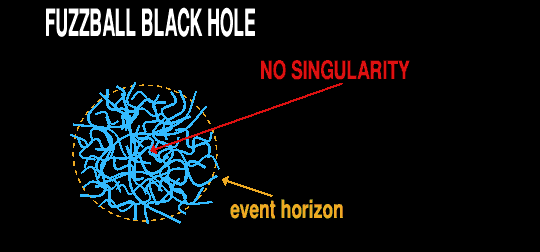
Relaxed Dilated Strings within a Fuzzball

One theorist believes that there is no central point singularity where matter is infinitely dense, and that within the Black Hole Event Horizon millions of vibrating strings and membranes swarm instead, the theorised identity of sub-atomic particles. Normally, strings are just 10-35 metres long and extremely taught, but in the crushing gravity of the Black Hole, the strings behave completely differently expanding in length to the size of the Event Horizon within and becoming very slack, losing their rigidity. Being both relaxed and dilated, they vibrate with much lower frequencies. It is the strings and membranes together with their vibrational modes which contain all the entropy of the Black Hole. And, extending to the very Event Horizon of the Black Hole, are able to transfer some entropy from within to the Black Body radiation that continually escapes from the Black Hole as Hawking Radiation, quite unlike the central singularity which is entirely cut-off from the Event Horizon. These fuzzy-at-the edge Black Holes are known as Fuzzballs. Because the matter within Fuzzballs is distributed throughout instead of at a single central point, the Event Horizon is not a sharp boundary, but rather indeterminate, fuzzy, but Fuzzballs still trap in-falling light and matter.
Other researchers point out that his calculations so far would only work for a fully charged Black Hole, one containing the maximum possible electrical charge, which are thought not to exist. But he is confident that the quantum calculations can be extended to include neutral Black Holes. If so, then this could also explain another puzzle in cosmology, why the Universe is so uniform in Cosmic Microwave Background Radiation. At the moment, cosmic inflation at the Big Bang has been invoked as a possible mechanism for evening out the temperature of 'vast' regions of space which could not possibly have been physically connected, but with this new theory, inflation is not required. At the Big Bang, where matter was concentrated just as it is in Black Holes, the elongated strings would even out the temperature.
The test of this theory is to observe the Hawking Radiation to see if it carries away entropy. Unfortunately, all in-directly observed Black Holes in the cosmos are huge, and have characteristic Hawking Temperatures of much less than 60 nano Kelvin (the temperature of a solar-mass Black Hole), which is swamped by the Background Microwave characteristic temperature which is a lot hotter at 2.7251 Kelvin. Our only hope in this matter is to observe the Hawking Radiation from much smaller (and therefore much hotter) Black Holes, but so far no one has ever found one.
In lieu of the perhaps remote possibility of finding a mini Black Hole just passing through Earth, maybe the remnant of one created during the turmoil of the Big Bang, it may be possible to make one here on Earth. But according to present theories of gravity, this task would require accelerators capable of producing 1013 times that currently achievable in order to get enough energy (mass) into a small enough volume such that it collapses in on itself by gravitational collapse. Not only that, but there is virtually no chance of ever being able to create such a powerful accellerator, either now, or in the future. However, if, as some theories suggest, gravity is actually much stronger than we think it is, then it may be possible after all. For a long while it has been a puzzle why gravity is so weak in comparison to other forces, being some 1040 times weaker than the electromagnetic force. If there exist more than 3 spacial dimensions, with the extra six or seven being rolled up so tight as to be virtually undetectable by us, and gravity was the only force to inhabit these extra dimensions, the gravity that we would observe would be greatly attenuated. But for any Black Hole that was small enough compared to those extra dimensions, it would feel the full un-abated true strength of gravity, and the energy required to create such a Black Hole would not be so huge after all. It should even be achievable with the Large Hadron Collider, which will smash protons head on in 2007 at collision energies of 14TeV with enough flux to create several mini-Black Holes per second. The Black Holes would be of 10-20 metres, and should evaporate by Hawking Radiation in 10-26 seconds, with each one producing a large number of high-energy particles. If extra minutely rolled-up dimensions of space do exist, then we should observe, if not the Black Holes themselves, the products of their evaporation.
It has been calculated that the most information, or entropy, a completely evaporated Black Hole could retain is just half a bit of information.
See Gravastars for another alternative theory of Black Holes.
![]()
![]()